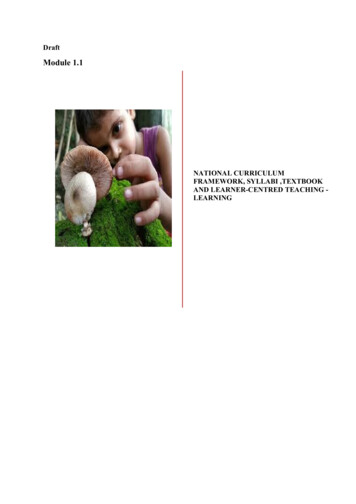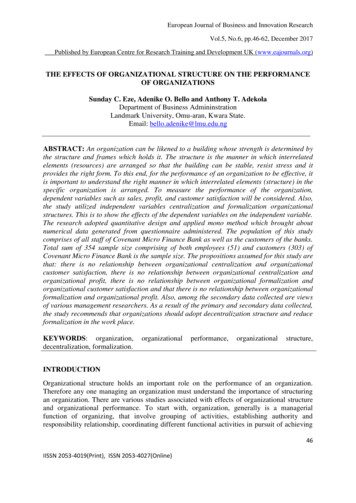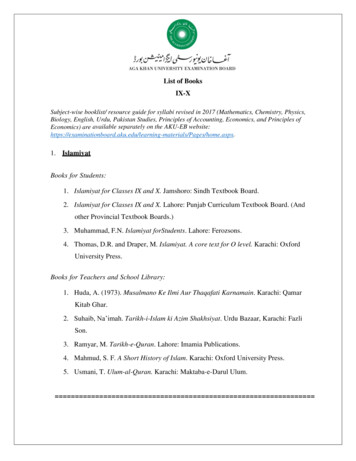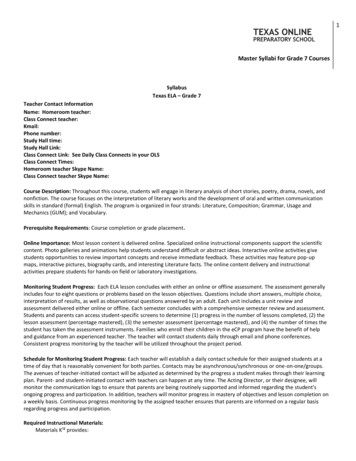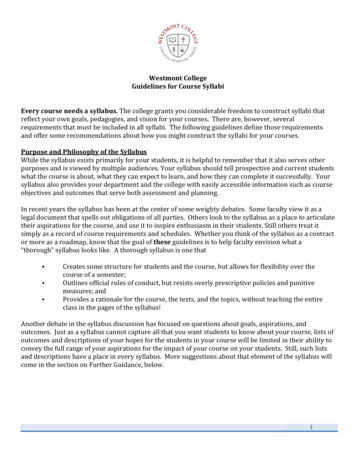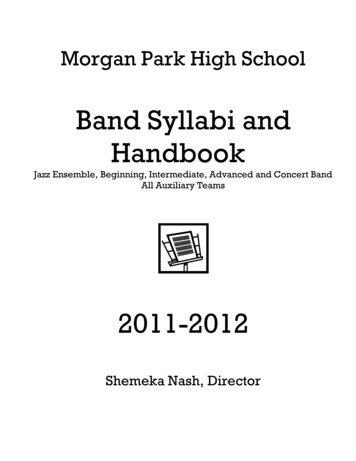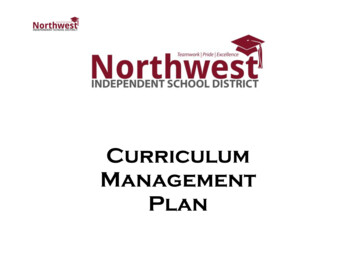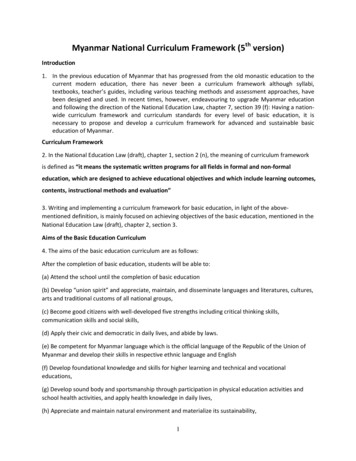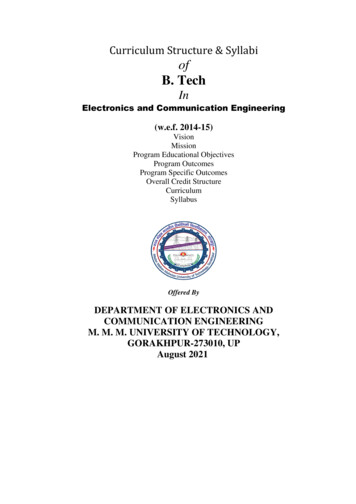
Transcription
Curriculum Structure & SyllabiofB. TechInElectronics and Communication Engineering(w.e.f. 2014-15)VisionMissionProgram Educational ObjectivesProgram OutcomesProgram Specific OutcomesOverall Credit StructureCurriculumSyllabusOffered ByDEPARTMENT OF ELECTRONICS ANDCOMMUNICATION ENGINEERINGM. M. M. UNIVERSITY OF TECHNOLOGY,GORAKHPUR-273010, UPAugust 2021
B. Tech: ECE, Curriculum & Syllabi, MMMUT Gorakhpur (2021), Version:1Department of Electronics and Communication EngineeringCURRICULA & SYLLABIB. Tech. Electronics and Communication EngineeringVision:To become a leader of education, research and innovation in the area of Electronics andCommunication Engineering and to train students to be innovative and well preparedprofessionals in the area of Electronics and Communication Engineering.Mission:1. Educate and mentor students to meet the current as well as future challenges byproviding them with a firm foundation in both theory and practice of Electronics andCommunication Engineering.2. Create, develop and disseminate new knowledge by top quality applied research inElectronics and Communication Engineering by interacting with government agenciesand private industry.3. Promote a sense of leadership and service to the society.Program Educational Objectives (PEOs)PEO-1:Excel in professional career and/or higher education by acquiring knowledge inarea of Electronics and Communication Engineering.PEO-2:Analyze real life problems, design appropriate system to provide solutions that aretechnically sound, economically feasible and socially acceptable.PEO-3:Exhibit professionalism, ethical attitude, communication skills, teamwork in theirprofession and adapt to current trends by engaging in life-long learning.Programs Outcomes (POs)B.Tech. Electronics and Communication Engineering students will demonstrate the abilityto:PO-1Engineering knowledge: Apply the knowledge of mathematics, science,engineering fundamentals, and an engineering specialization to the solution ofcomplex engineering problems.PO-2Problem analysis: Identify, formulate, review research literature, and analyze complexengineering problems reaching substantiated conclusions using first principles ofmathematics, natural sciences, and engineering sciences.PO-3Design/development of solutions: Design solutions for complex engineeringproblems and design system components or processes that meet the specified needswith appropriate consideration for the public health and safety, and the cultural,societal, and environmental considerations.Conduct investigations of complex problems: Use research-based knowledge andresearch methods including design of experiments, analysis and interpretation ofdata, and synthesis of the information to provide valid conclusions.Modern tool usage: Create, select, and apply appropriate techniques, resources,and modern engineering and IT tools including prediction and modeling to complexPO-4PO-51
B. Tech: ECE, Curriculum & Syllabi, MMMUT Gorakhpur (2021), g activities with an understanding of the limitations.The engineer and society: Apply reasoning informed by the contextual knowledgeto assess societal, health, safety, legal and cultural issues and the consequentresponsibilities relevant to the professional engineering practice.Environment and sustainability: Understand the impact of the professionalengineering solutions in societal and environmental contexts, and demonstrate theknowledge of, and need for sustainable development.Ethics: Apply ethical principles and commit to professional ethics andresponsibilities and norms of the engineering practice.Individual and team work: Function effectively as an individual, and as a memberor leader in diverse teams, and in multidisciplinary settings.Communication: Communicate effectively on complex engineering activities withthe engineering community and with society at large, such as, being able tocomprehend and write effective reports and design documentation, make effectivepresentations, and give and receive clear instructions.Project management and finance: Demonstrate knowledge and understanding ofthe engineering and management principles and apply these to one’s own work, asa member and leader in a team, to manage projects and in multidisciplinaryenvironments.Life-long learning: Recognize the need for and have the preparation and ability to engagein independent and life-long learning in the broadest context of technological change.Programs Specific Outcomes (PSOs)An ability to understand the concepts of basic Electronics & Communication EngineeringPSO-1PSO-2PSO-3and to apply them to various areas like Signal processing, VLSI, Embedded systems,Communication Systems, Digital & Analog Devices, etc.An ability to solve complex Electronics and Communication Engineering problems,using latest hardware and software tools, along with analytical skills to arrive costeffective and appropriate solutions.Wisdom of social and environmental awareness along with ethical responsibility tohave a successful career and to sustain passion and zeal for real-world applicationsusing optimal resources as an Entrepreneur.2
B. Tech: ECE, Curriculum & Syllabi, MMMUT Gorakhpur (2021), Version:1The Overall Credit Structure for B. Tech. ProgrammeCredit CoursesUndergraduate Core (UC)Undergraduate Electives (UE)CategoryMin.CategorycreditsBasic Sciences & Maths36Program Electives (PE)(BSM)Engineering Fundamentals (EF) 24Open Electives (OE) (OtherDepartments)Department Core (DC)78Humanities & Social ScienceElectives (HSSE)Management (M)6Humanities & Social ScienceCore (HSSC)4Project (P)10Total158TotalGrand TotalMin.credits163322180(min.)Audit CoursesAudit Courses (Other Departments)16(min.)31SeminarIndustrial/Practical Training (IT)Grand Total20(min.)Credit Structure for B.Tech. Electronics & Communication EngineeringCategorySemestersI II III IV V VI VII VIII TotalBasic Sciences & Maths (BSM)9 14 9 4- 36Engineering Fundamentals (EF)12 7 7 2- 28Department Core (DC)9 13 20 23 95 79Management (M)4 37Humanities & Social Science Core (HSSC)44Project(P)55 10Programme Electives (PE)89 17Open Electives (OE)44Humanities & Social Science Electives(HSSE) 33Total25 24 25 23 23 23 22 23 1883
B. Tech: ECE, Curriculum & Syllabi, MMMUT Gorakhpur (2021), Version:1Structure of the CurriculumCurriculum for B.Tech.(Electronics & Communication Engineering)Freshman Year, Semester: IS.N. CategoryPaper CodeSubjectL1.BSMBPM-01/BAS-02Engineering Physics-I32.EFBEC-01Fundamentals of Electronics 3Engineering3.BSMBMS-01/BAS-01Engineering Mathematics-I34.EFBEE-02Electrical Circuits &3Analysis5.HSSCBHM-01/BAS-03 Professional Communication 36.EFBEC-10Electronics Workshop &PCB 07.ACBCY-04/BAS-05Environment and Ecology2Total17Freshman Year, Semester: IIS.N. Category Paper MBA-HR6SubjectEngineering Physics-IIEngineering ChemistryEngineering Mathematics-IIHumanities &Social ScienceElectivesIntroduction to ComputerProgrammingEngineering GraphicsKnowledge ManagementTotalSubjectEngineering Mathematics-IVSignals &SystemsElectromagnetic Field TheorySolid State Devices &CircuitsPublic AdministrationWeb DesigningIndustrial ManagementTotal4P22Credits551102451 00 41 06 104225L3332T1111P2200Credits554331250 02 116 e Year, Semester: IIIS.N. Category Paper CodeSubjectL1.BSMBMS-04/BAS-21 Engineering Mathematics-III32.EFBEE-16Electromechanical Energy3Conversion3.BSMBPM-05/BAS-28 Solid State Physics34.DCBEC-11Network Analysis & synthesis 35.DCBEC-12Digital Electronics & Circuits 36.EFBHM-03/BAS-20 Communication Skills07.ACBMP-04/BAS-22 Nano Technology2Total17Sophomore Year, Semester: IVS.N. Category Paper 016P Credits0404042504420623
B. Tech: ECE, Curriculum & Syllabi, MMMUT Gorakhpur (2021), Version:1Junior Year, Semester: VS.N. Category Paper -296.ACMMS-232/BOE-03Junior Year, Semester: VIS.N. Category Paper C-356.ACBEC-30Senior Year, Semester: VIIS.N. Category Paper EC-406.ACBEC-45Senior Year, Semester: VIIIS.N. CategoryPaper EC-50SubjectEngineering and ManagerialEconomicsControl SystemsAnalog Integrated CircuitsPrinciples of CommunicationElectronics Measurement &InstrumentationOperation ResearchL2T P Credits1 033333111122225555310-Total17 6823SubjectDigital CommunicationMicroprocessors & ApplicationData Communication NetworksMicrowave EngineeringVLSI TechnologySeminarTotalSubjectVLSI DesignDigital Signal t Part-IIndustrial/ Practical TrainingTotalSubjectWireless CommunicationProgram Elective-3Program Elective-4Open ElectiveProject Part-IITotal5L T P3 1 23 1 23 1 03 1 23 1 00 0 615 5 22001012Credits5544523L3333012T1111004T111104
B. Tech: ECE, Curriculum & Syllabi, MMMUT Gorakhpur (2021), Version:1Engineering Fundamentals & Department Core (Electronics & CommunicationEngineering)S.N. PaperSubjectPrerequisiteL T P CreditsCodeSubjectYear-I1.BEC-01 Fundamentals of Electronics 3 1 25Engineering2.BEC-10 Electronics Workshop &0 0 42PCBYear-II3.BEC-11 Network Analysis &3 1 04Synthesis4.BEC-12 Digital Electronics3 1 25&Circuits5.BEC-13 Signals &Systems3 1 046.BEC-14 Electromagnetic Field3 1 04Theory7.BEC-15 Solid State Devices &Solid State Devices3 1 25Circuits& CircuitsYear-III8.BEC-26 Control Systems3 1 259.BEC-27 Analog Integrated Circuits3 1 2510. BEC-28 Principles ofSignals &Systems3 1 25Communication11. BEC-29 Electronics Measurement & 3 1 25Instrumentation12. BEC-31 Digital CommunicationPrinciples of3 1 25Communication13. BEC-32 Microprocessors &Digital Electronics & 3 1 25ApplicationCircuits14. BEC-33 Data CommunicationPrinciples of3 1 04NetworksCommunication15. BEC-34 Microwave EngineeringElectromagnetic3 1 25Field Theory16. BEC-35 VLSI Technology3 1 0417. BEC-30 Seminar0 0 63Year-VI18. BEC-41 VLSI DesignVLSI Technology3 1 2519. BEC-42 Digital Signal ProcessingSignals &Systems3 1 0420. BEC-40 Project Part-I0 0 10521. BEC-45 Industrial/ Practical0 0 21Training22. BEC-43 Wireless CommunicationPrinciples of3 1 25Communication23. BEC-50 Project Part-IIProject Part-I0 0 1056
B. Tech: ECE, Curriculum & Syllabi, MMMUT Gorakhpur (2021), Version:1Program Electives (Electronics & Communication Engineering)S.N. PaperSubjectPrerequisite SubjectCodePE1 & PE2 (VII Semester)1.BEC-51 RADAR TechnologyElectromagnetic FieldTheory2.BEC-52 Biomedical Instrumentation Fundamentals ofElectronicsEngineering3.BEC-53 Information Theory &DigitalCodingCommunication4.BEC-54 Advance SemiconductorDevices5.BEC-55 OptoelectronicsSolid State Devices &Circuits6.BEC-56 Electronics Switching7.BEC-57 Digital System Design-8.BEC-58 Satellite CommunicationsPrinciples ofCommunicationPE3 (VIII Semester)9.BEC-61 Microcontroller &Digital Electronics &Embedded SystemsCircuits10. BEC-62 Optical CommunicationsPrinciples ofCommunication11. BEC-63 DSP ArchitectureDigital Signal&ApplicationsProcessing &Microprocessor12. BEC-64 Antenna DesignElectromagnetic FieldTheoryPE4 (VIII Semester)13. BEC-65 Digital Image ProcessingSignals &Systems,DSP14. BEC-66 ATM Networks and BData CommunicationISDNNetworks15. BEC-67 RFICsAnalog IntegratedCircuits16. BEC-68 Neural NetworksSubjects offered for other departmentsS.N. PaperSubjectPrerequisite SubjectCode1.BOE-13 Industrial Automation & Robotics2.BOE-14 Industrial 3.BOE-15 Electronic ProductFundamentals ofDesignElectronics Engg. & PCBDesign# Seminars, project works may be considered as practical7L T P 531253104310431043104L T P Credits210321032103
B. Tech: ECE, Curriculum & Syllabi, MMMUT Gorakhpur (2021), Version:1SYLLABIBPM-01/BAS02Course categoryPre-requisite SubjectContact hours/weekNumber of CreditsCourse AssessmentmethodsENGINEERING PHYSICS-I:::::Basic Sciences & Maths (BSM)NILLecture: 3, Tutorial : 1 , Practical: 25Continuous assessment through tutorials, attendance, homeassignments, quizzes, practical work, record, viva voce and ThreeMinor tests and One Major Theory & Practical ExaminationCourse Outcomes: The students are expected to be able to demonstrate the followingknowledge, skills and attitudes after completing this course1. Basics of relativity and its application in Engineering.2. Quantum Mechanics and its applications to understand material properties.3. Use of the principle of optics in the engineering and instrumentation.4. Basic Principles and applications of Laser, holography and optical Fibre in Engineering.Topics CoveredUNIT-I9Relativistic Mechanics: Inertial and Non-inertial Frames of reference, Galileantransformation, Michelson-Morley Experiment, Postulates of special theory of relativity,Lorentz Transformation, Length contraction, Evidences of length contraction, Timedilation, Evidences for time dilation, Relativistic velocity transformation, Relativisticvariation of mass with velocity, Evidence of mass variation with velocity, Relativistickinetic energy, Mass energy equivalence, Examples from nuclear physics, Relativisticenergy-momentum relation.UNIT-II9Quantum Mechanics: De Broglie waves and Group velocity concept, Uncertainty principleand its application, Davisson-Germer experiment, Derivation of Schrodinger equation fortime independent and time dependent cases. Postulates of quantum mechanics, Significanceof wave function, Application of Schrodinger wave equation for a free particle (onedimensional and three dimensional case), Particle in a box (one dimensional ), Simpleharmonic oscillator (one dimensional).UNIT-III9Physical Optics:Interference: Interference of light, Interference in thin films (parallel and wedge-shapedfilm), Newton’s rings. Refractive index and wavelength determination.Diffraction: Single, double and N- Slit Diffraction, Diffraction grating, Grating spectra,dispersive power, Rayleigh’s criterion and resolving power of grating.Polarization: Phenomena of double refraction, Nicol prism, Production and analysis ofplane, circular and elliptical polarized light, Retardation Plate, Polarimeter8
B. Tech: ECE, Curriculum & Syllabi, MMMUT Gorakhpur (2021), Version:1UNIT-IV9Modern OpticsLaser: Spontaneous and stimulated emission of radiation, population inversion, concept of 3and 4 level Laser, construction and working of Ruby, He-Ne lasers and laser applications.Fiber Optics: Fundamental ideas about optical fiber, Propagation mechanism, Acceptanceangle and cone, Numerical aperture, Propagation Mechanism, and communication in fiberSingle and Multi Mode Fibers, step index and graded index fiber.Holography: Basic Principle of Holography, Construction, and reconstruction of Image onhologram and applications of holography.EXPERIMENTS1. To determine the wavelength of monochromatic light by Newton’s Ring2. To determine the specific rotation of cane sugar solution using polarimeter3. To determine the wavelength of spectral lines using plane transmission grating.4. To verify Brewster’s law using rotating Nicol prism5. To verify Stefan’s law by electrical method6. To Study resonance in LCR circuit with a c source.7. To determine the height of a tower with a Sextant.8. To determine the refractive index of a liquid by Newton’s ring.Books & References1. Introduction to Special theory Relativity-Robert Resnick, Wiley Eastern Ltd.2. Statistical Mechanics and Properties of Matter- E S R Gopal, John Wiley and Sons3. Quantum Mechanics: Theory and Applications- Ajoy Ghatak, Tata McGraw-Hill4. Optics- Ajoy Ghatak, Tata McGraw-Hill5. Optics- N. Subrahmanyam, Brij Lal, M.N. Avadhanulu, S. Chand6. Fiber optics and laser Principles and Applications-Anuradha De, New Age International7. Concepts of Modern Physics-Arthur Beiser, Tata McGraw-Hill9
B. Tech: ECE, Curriculum & Syllabi, MMMUT Gorakhpur (2021), Version:1BEC-01FUNDAMENTAL OF ELECTRONICS ENGINEERINGCourse categoryPre-requisite SubjectContact hours/weekNumber of CreditsCourse Assessmentmethods:::::Engineering Fundamentals (EF)NILLecture : 3, Tutorial : 1 , Practical: 25Continuous assessment through tutorials, attendance, homeassignments, quizzes, practical work, record, viva voce and minorand major theory & practical ExaminationCourse Outcomes: The students are expected to be able to demonstrate the followingknowledge, skills and attitudes after completingthis course1. Able to identify schematic symbols and understand the working principles of electronicdevices, e.g., Diode, Zener Diode, LED, BJT, JFET and MOSFETetc.2. Able to understand the working principles of electronic circuits e.g. Rectifiers, Clipper,Clamper, Filters, Amplifiers and Operational Amplifiers etc. also understand methods toanalyse and characterize these circuits3. Able to understand the functioning and purposes of Power Supplies, Test and Measuringequipments such as multimeters, CROs and function generator sets.4. Able to rig up and test small electronics circuits.Topics CoveredUNIT-I9Semiconductor materials and properties: electron-hole concepts, Basic concepts of energybands in materials, concept of forbidden gap, Intrinsic and extrinsic semiconductors, donorsand acceptors impurities, Junction diode, p-n junction, depletion layer, v-i characteristics,diode resistance, capacitance, diode ratings (average current, repetitive peak current, nonrepetitive current, peak inverse voltage). Diode Applications in rectifier, filters, voltagemultipliers, load regulators, clipper and clamper circuits, Breakdown mechanism (Zener andavalanche), breakdown characteristics, Zener resistance, Zener diode ratings, Zener diodeapplication as shunt regulator9UNIT-IIBipolar Junction Transistor (BJT): Basic construction, transistor action, CB, CE and CCconfigurations, input/output characteristics, Biasing of transistors-fixed bias, emitter bias,potential divider bias, comparison of biasing circuits. Transistor Amplifier: Graphical analysisof CE amplifier, concept of voltage gain, current gain, h- parameter model (low frequency),computation of Ai, Av, Ri, Ro of single transistor CE and CC amplifier configurations.10
B. Tech: ECE, Curriculum & Syllabi, MMMUT Gorakhpur (2021), Version:1UNIT-III9Field Effect Transistors (JFET and MOSFET): Basic construction, transistor action, concept ofpinch off, maximum drain saturation current, input and transfer characteristics, characteristicequation CG, CS and CD configurations, fixed & self-biasing. MOSFET: depletion andenhancement type MOSFET-construction, operation and characteristics. Computation of Av,Ri, Ro, of single FET amplifiers using all the three configurations. Operational Amplifiers:Concept of ideal operational amplifiers, ideal op-amp parameters, inverting, non-inverting andunity gain amplifiers, adders, difference amplifiers, integratorsUNIT-IV9Switching theory and logic design: Number systems, conversion of bases, Boolean algebra,logic gates, concept of universal gate, canonical forms, Minimization using K-mapOperational AmplifiersElectronics Instruments: Working principle of digital voltmeter, digital multimeter (blockdiagram approach), CRO (its working with block diagram), measurement of voltage, current,phase and frequency using CROEXPERIMENTSA. Compulsory Experiments1. To identify the components which are used in electronic circuits.2. To get familiarization and to study the operation of a function generatorinstrument and visualize the types of waveforms produced by a function generator.3. To study the CRO and to find the Amplitude and Frequency of a sinusoidal waveformusing CRO.4. To plot and analyze the forward and Reverse Characteristics of Si based P-N junctiondiode.5. To implement a circuit to study the various applications of Operational Amplifier.6. Study of half wave rectifier.7. Operation of diode based clipper and clamper circuits.B. Optional Experiments1. Implement a circuit to draw the characteristics of JFET in common source configuration.2. Implement a circuit of half wave and full wave rectifiers with filters.3. Implement a circuit to draw the characteristics of common emitter BJT amplifier.Books & References1. Electronic Devices and Circuits-Boylestad and Nashelsky, 6e, PHI,2001.2. Electronic Devices and Circuits, A Mottershead, PHI, 2000,6e.3. Digital Computer Design, Morris Mano, PHI, 2003.4. Electronic Instrumentation-H.S. Kalsi, 2e, TMH,2007.11
B. Tech: ECE, Curriculum & Syllabi, MMMUT Gorakhpur (2021), Version:1BMS-01/BAS-01Course categoryPre-requisite SubjectContact hours/weekNumber of CreditsCourse Assessmentmethods:::::Course Outcomes:ENGINEERING MATHEMATICS-IBasic Sciences & Maths (BSM)NILLecture: 3, Tutorial: 1, Practical: 04Continuous assessment through tutorials, attendance, homeassignments, quizzes and One Minor tests and One Major TheoryExaminationThe students are expected to be able to demonstrate the followingknowledge, skills and attitudes after completing this course1. Use of basic differential operators in various engineering problems.2. Solve linear system of equations using matrix algebra.3. Use vectors to solve problems involving force, velocity, work and real-life problems andable to analyze vectors in space4. Evaluate and use double integral to find area of a plane region and us of triple integral tofind the volume of region in 3rd dimensionTopics CoveredUNIT-I9Differential Calculus: Leibnitz theorem, Partial derivatives, Euler’s theorem forhomogenous function, Total derivative, Change of variable. Taylor’s and Maclaurin’stheorem. Expansion of function of two variables, Jacobian, Extrema of function of severalvariables.UNIT-II9Linear Algebra: Rank of Matrix, Inverse of a Matrix, Elementary transformation,Consistency of linear system of equations and their solution. Characteristic equation,Eigenvalues, Eigen-vectors, Cayley-Hamilton theorem.UNIT-III9Multiple Integrals: Double and triple integrals, change of order of integration, change ofvariables. Application of multiple integral to surface area and volume. Beta and Gammafunctions, Dirichlet integral.UNIT-IV9Vector Calculus: Gradient, Divergence and Curl. Directional derivatives, line, surface andvolume integrals. Applications of Green’s, Stoke’s and Gauss divergence theorems (withoutProofs).Books & References1. B.S. Grewal: Higher Engineering Mathematics; Khanna Publishers.2. B.V. Ramana: Higher Engineering Mathematics, Tata Mc. Graw Hill Education Pvt. Ltd.,New Delhi.3. H.K. Dass and Rama Verma: Engineering Mathematics; S. Chand Publications.4. N.P. Bali and Manish Goel: Engineering Mathematics; Laxmi Publications.12
B. Tech: ECE, Curriculum & Syllabi, MMMUT Gorakhpur (2021), Version:1BEE-02Course categoryPre-requisite SubjectContact hours/weekNumber of CreditsCourse Assessmentmethods:::::Course Outcomes:ELECTRICAL CIRCUIT ANALYSISEngineering Fundamentals (EF)Physics and Math (10 2)Lecture: 3, Tutorial: 1, Practical: 25Continuous assessment through tutorials, attendance, homeassignments, quizzes and One Minor tests and One Major TheoryExaminationThe students are expected to be able to demonstrate the followingknowledge, skills and attitudes after completing this course1. Solve the dc electrical circuit parameters using basic circuit laws and theorems.2. Analyse the ac circuit behaviour with different combination of linear active and passiveelements.3. Analyse the transient behaviour of ac circuit and find the effectiveness of current andvoltage waveforms on electrical circuits.4. Solve parameters of three phase balanced ac circuits and single-phase magnetic circuitsTopics CoveredUNIT-I9D C Circuit Analysis and Network Theorems: 9 Circuit Concepts: Concepts of network,Active and passive elements, Voltage and current sources, Concept of linearity and linearnetwork, Unilateral and bilateral elements, R, L and C as linear elements, Sourcetransformation Kirchhoff’s laws; Loop and nodal methods of analysis; Star-deltatransformation Network theorems: Superposition theorem, Thevenin’s theorem, Norton’stheorem, Maximum Power Transfer theorem, Reciprocity theorem, Millman’s theoremUNIT-II9Analysis of Single Phase AC Circuits: 9 Complex quantities, the operator J, Representationof vectors, forms of expression of complex quantities, complex expression of voltage ,current and impedance, addition and subtraction of Steady State , AC fundamentals,Sinusoidal, square and triangular waveforms, Average and effective values, Form and peakfactors, Concept of phasors, phasor representation of sinusoidally varying voltage andcurrent, Analysis of series, parallel and series parallel RLC Circuits, Resonance in series andparallel circuits, bandwidth and quality factor; Apparent, active & reactive powers, Powerfactor, Causes and problems of low power factor, Concept of power factor improvement.UNIT-III9Transient State Analysis: 9 Transient response of series RL circuit with alternating voltagesource, Transient Response Analysis of series RC circuit, Transient Response Analysis ofseries RLC circuit. Non sinusoidal waves: generation of non- sinusoidal waves, Fourieranalysis, constants in Fourier series, Effective values of complex wave, power and powerfactor. Need of Earthing of equipment and devices, important electrical safety issuesUNIT-IV9Three Phase AC Circuits: 9 Three phase system its necessity and advantages, Star and13
B. Tech: ECE, Curriculum & Syllabi, MMMUT Gorakhpur (2021), Version:1delta connections, Balanced supply and balanced load, Line and phase voltage/currentrelations, Three phase power. Magnetic Circuit: Magnetic circuit concepts, analogy betweenelectric & magnetic circuits, B-H curve, Hysteresis and eddy current losses, Mutual couplingwith dot convention, Magnetic circuit calculations, Mutual inductance coupling coefficient.Experiments1. Verification of Kirchhoff’s law2. Verification of Norton’s theorem3. Verification of Thevenin’s theorem4. Verification of Superposition theorem5. Verification of Series R-L-C circuit6. Verification of Parallel R-L-C circuit7. Study of R-L-C series resonant circuit8. Study of R-L-C Parallel resonant circuitBooks & References1. K. S. Suresh Kumar: Electrical Circuit Analysis . Pearson, 20132. Lawrence P. Huelsman „Basic Circuit Theory”, 3rd ed. PHI3. T.K. Nagsakar & M.S. Sukhija „ Basic Electrical Engg‟., OXFORD, 2nd ed4. Samarjit Ghosh, „Network Theory: Analysis and Synthesis‟ PHI14
B. Tech: ECE, Curriculum & Syllabi, MMMUT Gorakhpur (2021), Version:1BHM-01/BAS-03Course categoryPre-requisite SubjectContact hours/weekNumber of CreditsCourse AssessmentmethodsPROFESSIONAL COMMUNICATION:::::Humanities & Social Science Core (HSSC)NILLecture: 3, Tutorial : 1 , Practical: 04Continuous assessment through tutorials, attendance, homeassignments, quizzes and Three Minor tests and One Major TheoryExaminationCourse Outcomes: The students are expected to be able to demonstrate the followingknowledge, skills and attitudes after completing this course1. Overcome the problems he/she faces in oral and written communication.2. Acquire knowledge of and methods for using technical communication, such as, reports,proposals and business letters etc.3. Use and practice compositions correctly.4. Give Presentations in different sessions and make self appraisal.5. Learn and understand the various facets of communication skills, such as, Reading, Writing, Listening and Speaking skills and identify, formulate and solve the real life problems withpositive attitude; also inculcate the habit of learning and developing the communication andsoft skillsTopics CoveredUNIT-I9CommunicationPrinciples of Communication – Communication as coding and decoding – signs and symbols– verbal and non –verbal symbols – Language AND communication; language VScommunication, language as a tool of communication – media/channels for communication :Types of Communication- functional, situational, verbal and non-verbal, interpersonal,group, interactive, public, mass line, dyadic – with illustrations LSRW in Communication –Listening – active vs passive (Talk less, listen more); Speaking - Speech vs. enunciation(mind your tone); Reading – Focus on the structure not on the theme alone, TechnicalCommunication, General Communication, Barriers of Communication, Levels ofCommunicationUNIT-II9Language Acquisition through Grammar, Usage and Mechanics of WritingVocabulary, Phrase, Clause, Parts of Speech: Types ,Examples with Use Gender, Singular,Plural, Article, Sequence of Tenses, Use of Modifiers, Sentence-Loose Sentence, PeriodicalSentence, Topic Sentence, Paragraph-Different Orders and Methods of Paragraph Writing,Inductive Method, Deductive Method, Spatial Method, Question and Answer Method,Chronological Method, Expository Method, Common Errors, Antonyms, Synonyms, Oneword Substitutes, Homophone, Homonym, Comprehension and Précis, Words FrequentlyMisspelt, Punctuation and Capitalization, Abbreviations and Numerals, Proofreading, Usingthe Library15
B. Tech: ECE, Curriculum & Syllabi, MMMUT Gorakhpur (2021), Version:1UNIT-III9Technical WritingReport Writing: Meaning, Types, Structure, Methods and Models of Report Writing,Technical Proposal; Concept, Kinds, Layout, and Examples of Technical Proposal,Definitions, Characteristics, Structure, Letter Writing: Importance, Types, Layout, andexamples of letters, Scientific and Technical Writing: Features, Methods, Examples, Project,Thesis and Dissertation WritingUNIT-IV9Spoken and Presentation SkillsImpromptu speech – tackling hesitation, shyness and nervousness in speaking – Publicspeaking, academic and professional presentations – Group discussions – facilitators andimpediments Planning, preparing and delivering a presentation, essentials of presentation etiquet
8. BEC-26 Control Systems - 3 1 2 5 9. BEC-27 Analog Integrated Circuits - 3 1 2 5 10. BEC-28 Principles of Communication Signals &Systems 3 1 2 5 11. BEC-29 Electronics Measurement & Instrumentation - 3 1 2 5 12. BEC-31 Digital Communication Principles of Communication 3 1 2 5 13. BEC-32 Microprocessors & Application
